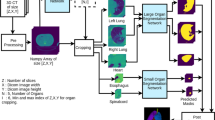Abstract
The multi-organ contouring (MOC) task is required when a radiotherapy is performed to eradicate the cancerous tissue while minimizing the dosage delivered to the surrounding healthy organs. Currently most of the task is done manually with enormous labor and time cost. To reduce the scheduling waiting time from increasing cancer population, it is beneficial to both the patients and therapeutists to have an automatic contouring tool. In this work an Attention-LSTM fused U-Net model is proposed to perform the multiple organ segmentation from a CT image series. The organs to be delineated include lung, liver, stomach, esophagus, heart, and kidneys. To train and evaluate our model, the CT image series of 146 patients was acquired from a local hospital with IRB approval. The segmentation accuracy of the six organs in terms of Dice Similarity Coefficient (DSC) were 99.27%, 95.48%, 88.53%, 80.81%, 93.8%, and 93.46%, respectively. To make the AI-embedded MOC system readily applicable in clinical environments, a data processing workflow and the corresponding GUI were also implemented and published on Github. The doctors can download the CT image data from the PACS server, use our system to perform MOC tasks, and output the contouring results in DICOM-RT format so they can be uploaded back to the treatment planning system for further fine-tuning and dosage/path calculation. To our best knowledge the work might be the first non-commercial model-integrated system compatible with the commercial treatment planning systems and ready to be used by the doctors.







Similar content being viewed by others
Data availability
No.
Code availability
References
Bilic P, Christ PF et al (2019) The Liver Tumor Segmentation Benchmark (LiTS). arXiv:1901.04056
Chen PH et al (2020) Attention-LSTM fused U-Net architecture for organ segmentation in CT images. International Symposium on Computer, Consumer and Control (IS3C)
Huang H et al (2020) UNet 3+: A Full-Scale Connected UNet for Medical Image Segmentation. ICASSP 2020–2020 IEEE International Conference on Acoustics, Speech and Signal Processing (ICASSP), Barcelona, Spain, pp 1055–1059
Liu Y, Lei Y, Fu Y, Wang T, Tang X, Jiang X, Curran WJ, Liu T, Patel P, Yang X (2020) CT-based multi-organ segmentation using a 3D self-attention U-Net network for pancreatic radiotherapy. Med Phys 47:4316–4324. https://doi.org/10.1002/mp.14386
Macchia ML et al (2012) Systematic evaluation of three different commercial software solutions for automatic segmentation for adaptive therapy in head-and-neck, prostate and pleural cancer. Radiat Oncol 7:160
Maitre AL et al (2012) Impact of the accuracy of automatic tumour functional volume delineation on radiotherapy treatment planning. Phys Med Biol 57(17):5381–5397
Mattiucci GC, Boldrini L, Chiloiro G, D’Agostino GR, Chiesa S, de Rose F, Azario L, Pasini D, Gambacorta MA, Balducci M, Valentini V (2013) Automatic delineation for replanning in nasopharynx radiotherapy: what is the agreement among experts to be considered as benchmark? Acta Oncol 52(7):1417–1422
Novikov AA et al (2019) Deep sequential segmentation of organs in volumetric medical scans. IEEE Trans Med Imaging 38(5):1207–1215
Oktay O, Schlemper J, Folgoc LL, Lee M, Heinrich M, Misawa K et al ( 2018) Attention u-net: Learning where to look for the pancreas. arXiv preprint arXiv:180403999
Ronneberger O et al (2015) U-net: convolutional networks for biomedical image segmentation. In: International Conference on Medical image computing and computer-assisted intervention. Springer, Cham
Shen C, Milletari F et al (2019) Improving V-Nets for multi-class abdominal organ segmentation. Proc. SPIE 10949, Medical Imaging 2019: Image Processing, 109490B
Shi X et al (2015) Convolutional LSTM Network: a machine learning approach for precipitation nowcasting. In: Proceedings of the 28th International Conference on Neural Information Processing Systems—volume 1 (NIPS’15). MIT Press, Cambridge
Sudre CH et al (2017) Generalised dice overlap as a deep learning loss function for highly unbalanced segmentations. In: Deep learning in medical image analysis and multimodal learning for clinical decision support. Springer, Cham, pp 240–248
Taha AA, Hanbury A (2015) Metrics for evaluating 3D medical image segmentation: analysis, selection, and tool. BMC Med Imaging 15(1):29
Tang H et al 2021 Spatial context-aware self-attention model for multi-organ segmentation. arXiv:2012.09279, accepted by WACV
Tang Y et al (2021) High-resolution 3D abdominal segmentation with random patch network fusion. Med Image Anal 69:101894
Thomson D et al (2014) Evaluation of an automatic segmentation algorithm for definition of head and neck organs at risk. Radiat Oncol 9:173
Tian Z et al (2020) A multiscale-based adjustable convolutional neural network for multiple organ segmentation. Wirel Commun Mob Comput 2020:Article ID 9595687 13 pages
Wang Y, Zhou Y, Shen W, Park S, Fishman EK, Yuille AL (2019) Abdominal multi-organ segmentation with organ attention networks and statistical fusion. Med Image Anal 55:88–102
Yang J, Beadle BM, Garden AS, Schwartz DL, Aristophanous M (2015) A multimodality segmentation framework for automatic target delineation in head and neck radiotherapy. Med Phys 42(9):5310–5320
Yu L et al (2017) Volumetric ConvNets with mixed residual connections for automated prostate segmentation from 3D MR images. Thirty-first AAAI conference on artificial intelligence
Acknowledgments
The work is supported by the grants from Ministry of Science and Technology, Taiwan (No.: MOST 108-2221-E-194 -042, MOST 110-2221-E-194-011).
Funding
Supported by the grant from Ministry of Science and Technology, Taiwan (No.: MOST 108–2221-E-194 -042).
Author information
Authors and Affiliations
Corresponding author
Ethics declarations
Conflicts of interest/competing interests
No conflict of interest regarding to the manuscript.
Ethics approval
IRB number B10804010-1 approved by Tzu Chi Hospital in Chiayi, Taiwan.
Consent to participate
Not applicable.
Consent for publication
Not applicable.
Additional information
Publisher’s note
Springer Nature remains neutral with regard to jurisdictional claims in published maps and institutional affiliations.
Rights and permissions
About this article
Cite this article
Chen, PH., Huang, CH., Chiu, WT. et al. A multiple organ segmentation system for CT image series using Attention-LSTM fused U-Net. Multimed Tools Appl 81, 11881–11895 (2022). https://doi.org/10.1007/s11042-021-11889-7
Received:
Revised:
Accepted:
Published:
Issue Date:
DOI: https://doi.org/10.1007/s11042-021-11889-7




